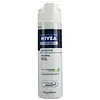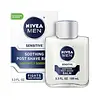What's inside
What's inside
 Key Ingredients
Key Ingredients

 Benefits
Benefits

 Concerns
Concerns

 Ingredients Side-by-side
Ingredients Side-by-side

Water
Skin ConditioningPalmitic Acid
EmollientTriethanolamine
BufferingOleth-20
CleansingIsopentane
SolventSorbitol
HumectantParaffinum Liquidum
EmollientIsobutane
Gossypium Herbaceum Seed Oil
Skin ConditioningTocopheryl Acetate
AntioxidantGlycine Soja Oil
EmollientChamomilla Recutita Flower Extract
MaskingBisabolol
MaskingPEG-90 Glyceryl Isostearate
CleansingHydroxyethylcellulose
Emulsion StabilisingPolyisobutene
Hydroxypropyl Methylcellulose
Emulsion StabilisingPEG-14m
Emulsion StabilisingLaureth-2
CleansingMethylparaben
PreservativePropylparaben
PreservativeBHT
AntioxidantParfum
MaskingWater, Palmitic Acid, Triethanolamine, Oleth-20, Isopentane, Sorbitol, Paraffinum Liquidum, Isobutane, Gossypium Herbaceum Seed Oil, Tocopheryl Acetate, Glycine Soja Oil, Chamomilla Recutita Flower Extract, Bisabolol, PEG-90 Glyceryl Isostearate, Hydroxyethylcellulose, Polyisobutene, Hydroxypropyl Methylcellulose, PEG-14m, Laureth-2, Methylparaben, Propylparaben, BHT, Parfum
Water
Skin ConditioningCyclomethicone
EmollientGlyceryl Lanolate
EmollientPanthenol
Skin ConditioningPropylene Glycol
HumectantIsopropyl Palmitate
EmollientTocopheryl Acetate
AntioxidantBisabolol
MaskingAllantoin
Skin ConditioningHamamelis Virginiana Water
AstringentGlycine Soja Hull
AbrasiveCalendula Officinalis Flower
Skin ConditioningCitric Acid
BufferingTriceteareth-4 Phosphate
EmulsifyingSodium Carbomer
Emulsion StabilisingPhenoxyethanol
PreservativeEthylparaben
PreservativeMethylparaben
PreservativePropylparaben
PreservativeButylparaben
MaskingParfum
MaskingWater, Cyclomethicone, Glyceryl Lanolate, Panthenol, Propylene Glycol, Isopropyl Palmitate, Tocopheryl Acetate, Bisabolol, Allantoin, Hamamelis Virginiana Water, Glycine Soja Hull, Calendula Officinalis Flower, Citric Acid, Triceteareth-4 Phosphate, Sodium Carbomer, Phenoxyethanol, Ethylparaben, Methylparaben, Propylparaben, Butylparaben, Parfum
 Reviews
Reviews

Ingredients Explained
These ingredients are found in both products.
Ingredients higher up in an ingredient list are typically present in a larger amount.
Bisabolol is famous for its skin soothing properties. It does this by blocking inflammatory signals, helping to reduce your body's reaction to irritation.
This ingredient also interferes with the process of hyperpigmentation. This can help with reducing dark spots and uneven tone.
Bisabolol is an antioxidant. Antioxidants help fight free-radicals. Free-radicals are molecules that may damage your skin cells. By fighting these free-radicals, Bisabolol may slow down signs of aging.
Studies have shown Bisabolol to have antimicrobial properties and may be a fungicide. These properties help preserve a product's shelf life.
All these properties makes bisabolol a great skin barrier helper ingredient.
Bisabolol also helps the absorption of other ingredients.
Note: Synthetic Bisabolol has been shown to be less effective.
Learn more about BisabololMethylparaben is a preservative and is a paraben. It is used to prevent the growth of fungus, mold, and other harmful bacteria. Parabens are chemicals used as preservatives in both cosmetics and food.
Methylparaben can be synthetically created. It can also be found naturally in some fruits, such as blueberries.
Oftentimes, Methylparaben is combined with other parabens to help increase the shelf life.
The safety of Methylparaben is currently being studied. While ongoing studies are looking into the safety of parabens, the results have been very mixed. Some studies have not found Methylparaben to be harmful.
Learn more about MethylparabenParfum is a catch-all term for an ingredient or more that is used to give a scent to products.
Also called "fragrance", this ingredient can be a blend of hundreds of chemicals or plant oils. This means every product with "fragrance" or "parfum" in the ingredients list is a different mixture.
For instance, Habanolide is a proprietary trade name for a specific aroma chemical. When used as a fragrance ingredient in cosmetics, most aroma chemicals fall under the broad labeling category of “FRAGRANCE” or “PARFUM” according to EU and US regulations.
The term 'parfum' or 'fragrance' is not regulated in many countries. In many cases, it is up to the brand to define this term.
For instance, many brands choose to label themselves as "fragrance-free" because they are not using synthetic fragrances. However, their products may still contain ingredients such as essential oils that are considered a fragrance by INCI standards.
One example is Calendula flower extract. Calendula is an essential oil that still imparts a scent or 'fragrance'.
Depending on the blend, the ingredients in the mixture can cause allergies and sensitivities on the skin. Some ingredients that are known EU allergens include linalool and citronellol.
Parfum can also be used to mask or cover an unpleasant scent.
The bottom line is: not all fragrances/parfum/ingredients are created equally. If you are worried about fragrances, we recommend taking a closer look at an ingredient. And of course, we always recommend speaking with a professional.
Learn more about ParfumPropylparaben is a preservative and is a paraben with antifungal and antimicrobial properties.
This ingredient can be naturally found in plants and insects, but most of it is synthetically manufactured for human use. In cosmetics, it is usually created by reacting para-aminobenzoic acid and propanol (an alcohol).
You can usually find this ingredient in water-based products.
Parabens have come under controversy due to the claim they are hormone disruptors. Studies show conflicting results. We recommend speaking with a professional if you have any concerns.
Propylparaben is commonly found in food, medicine, and cosmetics.
Learn more about PropylparabenTocopheryl Acetate is AKA Vitamin E. It is an antioxidant and protects your skin from free radicals. Free radicals damage the skin by breaking down collagen.
One study found using Tocopheryl Acetate with Vitamin C decreased the number of sunburned cells.
Tocopheryl Acetate is commonly found in both skincare and dietary supplements.
Learn more about Tocopheryl AcetateWater. It's the most common cosmetic ingredient of all. You'll usually see it at the top of ingredient lists, meaning that it makes up the largest part of the product.
So why is it so popular? Water most often acts as a solvent - this means that it helps dissolve other ingredients into the formulation.
You'll also recognize water as that liquid we all need to stay alive. If you see this, drink a glass of water. Stay hydrated!
Learn more about Water